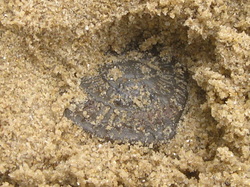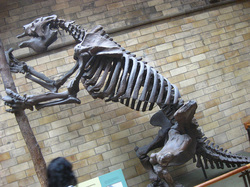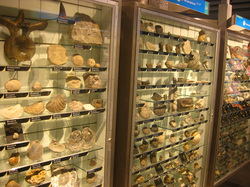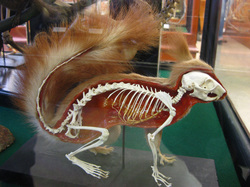
Thank you so much, Tinne!!
| Fossil Friends |
|
 When Mummy went to Germany, she met a lady called Tinne. Tinne is from Belgium, and she gave me some fossils. The fossils are from Fance and Holland (edit: thinks Mummy, she can't quite remember!) We don't know what all of them are, so you can come back to us and say what some of the fossils are. We think that there are a coral, a bivalve, a gastropod, some shark teeth, and an ammonite, and a belemnite or sea urchin spine... Thank you so much, Tinne!!
0 Comments
 Yesterday, we made an ammonite bowl. We had a big stamp, and we used glue to stamp ammonites onto glass.  Then we put colours on - the colours were red, black, blue and white, and they were actually glass, too. So we had to be really careful, because you can't breathe it in, it's super dangerous! If you breathe it in, it can really damage your lungs, so I was wearing goggles and a breathing mask, so I was super-safe. (Edit from Mummy: and we washed our skin and changed clothes when we went back in the house!)  This is what the bowl looked like when it went into the kiln. It didn't come out right, there's a big bubble in the middle, but you can hide a real ammonite underneath it, and so we still like it. We might have another go soon.  This is a fossilised feather from an archaeopteryx, and it is x-rayed. There is a palaeontologist at the University of Manchester, and he's called Dr Phil Manning, and he x-rayed the feather to find out what colours archaeopteryx feathers were.  And he found out that they were black and white! The x-ray light was brighter than a million suns! That is a lot - a million suns! You can read more on the University of Manchester website: http://www.manchester.ac.uk/aboutus/news/display/?id=10202 (edit from Mummy: bottom image taken from there, top image taken from http://blogs.rsc.org/ja/2013/06/13/plumage-patterns-in-a-150-million-year-old-bird-revealed/ )  Eight weeks ago, we covered up six things to make an archaeological dig. We wrote about it on the blog (you can read about it here). Today, we dug it up. I was really, really excited, I couldn't wait! I had a trowel, and this picture is me going across with my trowel very evenly.  This is a bit of my Lego brick. First we only saw a little bit, and I saw the word Lego on it. We carefully dug across and then when we got it all, we pulled it up, and we put it in our findings tray.  This is a little piece of banana skin, with the sticker on it. If it didn't have the sticker, we probably wouldn't have found it. It rotted away lots, and there were little bugs eating it. It was brown and nearly the same colour as the soil, just a bit darker!  This is the ammonite we found. It was still the same.  This is me cleaning the banana skin, my best find. It was most, most interesting! And there was another interesting find, and that was the paper - it was gone!!! The coin, the Lego brick and the ammonite stayed the same, because they were inorganic. The banana skin and the hyacinth leaf rotted away lots, and the paper was completely gone. Below are the pictures of the hyacinth leaf and the banana skin. It was super fun to do an archaeological dig - you can do it at home, you just need to print off some sheets of paper, and you have to find things to bury, and you have to do what the paper says, and you have to bury them for eight weeks. We got the idea from the BBC (http://downloads.bbc.co.uk/history/handsonhistory/dig_family.pdf).  I've been watching a programme about the ice age. It's called Ice Age Giants, and you can find it on the iPlayer from the BBC. The presenter is a lady called Professor Alice Roberts, she works at a university. There are three programmes. My favourite bit was the cave bear. The Mummy bear and the cub were going deep in the cave, but then a cave lion came and found them, but the Mummy cave bear killed the cave lion and protected her cub. There was lots about a giant sloth as well, but it wasn't called a megatherium, it was called the shasta giant sloth. And about Neanderthals and how they became extinct. There are lots of museums and places in the programme that I want to go to, so many that I can't even count them. There was a place near San Francisco were the stones were rubbed smooth by mammoths having a good scrub. I would love to travel all around the world and see all these places. You can read more about the programme here: http://www.bbc.co.uk/programmes/p018c9fm - and you can watch it for another five days. It is for grown ups, but I liked it! (Edit from Mummy: image taken from BBC link above.) Two days ago, I made a Lego Mary Anning cliff. And the mini figures were Mary Anning and her brother Joseph. There are a few crystals, a dinosaur tooth and an ichthyosaur, and a fossilised fish. Mary Anning has got a hammer and a cloak. We couldn't find a bonnet for her in my lego box. She had a little white dog, but I didn't have a white dog, I only have a grey and black dog, and that was a lot bigger, so we just put a cat in. And Joseph was bigger than Mary Anning, but in my Lego set he's smaller. Maybe when I have more Lego pieces that are grey, I can build it a lot higher and wider cliff, and maybe I'll get figures that fit better for the dog and Joseph.
 This is my fossil adventure game. It's bigger than this picture. I drew lots of pictures and circles to walk on, and then I wrote on them. The pictures are of an ammonite, a belemnite, a fossilised leaf, a parasaurolophus, an ichthyosaur head, a trilobite, and some fossilised teeth.  You have to roll the dice and the number it lands on, you have to go that many steps forward. If there's a message in the circle, then you have to do what it says. We played it lots yesterday, and this circle says "go to the trilobite", and there is a circle with a trilobite in it. Maybe you can make your own game at home, it can be any game you want!  We went to London. It was the first time I went to London. This is me waiting outside the Natural History Museum. It was a really, really rainy day. Mummy got really wet. We had to wait over half an hour.  This is a picture of Dippy, the diplodocus. He is in the middle of the museum and he is super, super, super, super big!  This is an ichthyosaur head that Joseph found. Joseph is Mary Anning's brother, and Joseph is a bit older than Mary Anning. The museum had lots of fossils of ichthyosaurs and plesiosaurs that Mary Anning found, but the picture of me, two pictures down, is with a pliosaur. It was so big that Mummy had to tilt the camera to take a picture!  This a megatherium. It was alive after the dinosaurs. While the dinosaurs were alive, mammals were as big as a mouse, but after the dinosaurs died, they grew bigger and bigger, and the megatherium was one of the biggest - it was much, much bigger than a bear!  They have lots of fossils in the museum. In this room, it was all full of fossils. They were found all over Great Britain. There was a computer that was stuck to a microscope, and you could look at fossils up close. There was another computer, and you could look up where they found the fossils.  This is an archaeopteryx. Scientists are arguing whether archaeopteryx was a dinosaur or an early bird - I think it is a dinosaur. This is what it would have looked like when it was alive.  I'm not telling you anything about this T Rex - you have to find out how scary it is when you go to London to the museum! The picture below is a parasaurolophus fossilised skull. He could make a noise with his big horn, it sounded a bit like the fog horn of a big ship. If you go to the Dinosaurierpark in Germany, you could hear what it sounded like, or you can have a look here: http://www.youtube.com/watch?v=lBU6zfI1b0U . It's a film to show how the horn worked, although it's really called a crest. But I didn't make that film. My best piece was when I saw the T Rex, even though it was scary. And I also liked the megatherium, and seeing all the fossils that Mary Anning found. One day, we're going to go back. It was so fun at the museum, I nearly cried when I got out, but that cry was a happy cry, I didn't want to leave!
 Today we went to the Ashton Memorial. It's in Lancaster. We were taking down Mummy's exhibition at one of her follies. As we walked up the stairs, we saw fossils! We saw shells, and one bit that might have been a coral. You can find fossils on rocks, and you can find fossils on the beach, and you can find fossils in forests, and you can find fossils on stairs!  Today we went to the Alfred Denny Museum. It's in the University of Sheffield, and you have to tell them you want to come. It's an animal museum. It's called zoology, and there are lots and lots and lots of creatures. There are some sponges and corals, and there was a dead person, and an ostrich and there was a snake and a hedgehog and a squirrel and an armadillo and a porcupine and bullfrogs and chicken embryos, and lots of other creatures.  This is half a squirrel. It has fur on one side, and it has bones on the other side. It's for students to learn what's inside the creatures. There was also half a seal, half a mole, half a bat, half a porpoise, half a hedgehog and half a bullfrog.  This is a little ichthyosaur. They had a cast of a fossil pterodactyl - the grown up and the babies are in the pictures below.  This is a terror bird. Can you see that eye? That's just a made up eye. The terror bird lived about 62-2 million years ago. It couldn't fly, but it grew taller than a person, and it was super dangerous. I had a really, really, really, really good time, and I want to go back another day. |
AuthorHello, my name is Toby. I am five years old, and I want to be a palaeontologist. I really like fossils, so I'm writing down everything I do with fossils! My Mummy is doing the typing until I'm a bit older, but she writes everything I say. Archives
September 2014
Categories
All
|